Data Exports
Learn how to export data from CleverTap to different Data Warehouse platforms.
Overview
CleverTap supports exporting raw event and profile data to cloud storage platforms such as Amazon S3, Google Cloud Storage, and Microsoft Azure.
These exports allow you to:
- Move platform data into your existing data lakes, warehouses, or Business Intelligence (BI) tools.
- Maintain independent backups for compliance and audits.
- Help personalize engagements using raw user and event data.
Exports can be scheduled or triggered as one-time deliveries and are available in standard file formats, including JSON, CSV, XML, and Parquet, to support a wide range of downstream systems.
Create export
To begin, you first create a new export from the CleverTap dashboard. This step connects your CleverTap account with a partner destination and sets the context for the following configuration.
- Go to Settings > Partners and click Create Export.

Create Export
- Under Data type, select Events or Profiles. Click Next.
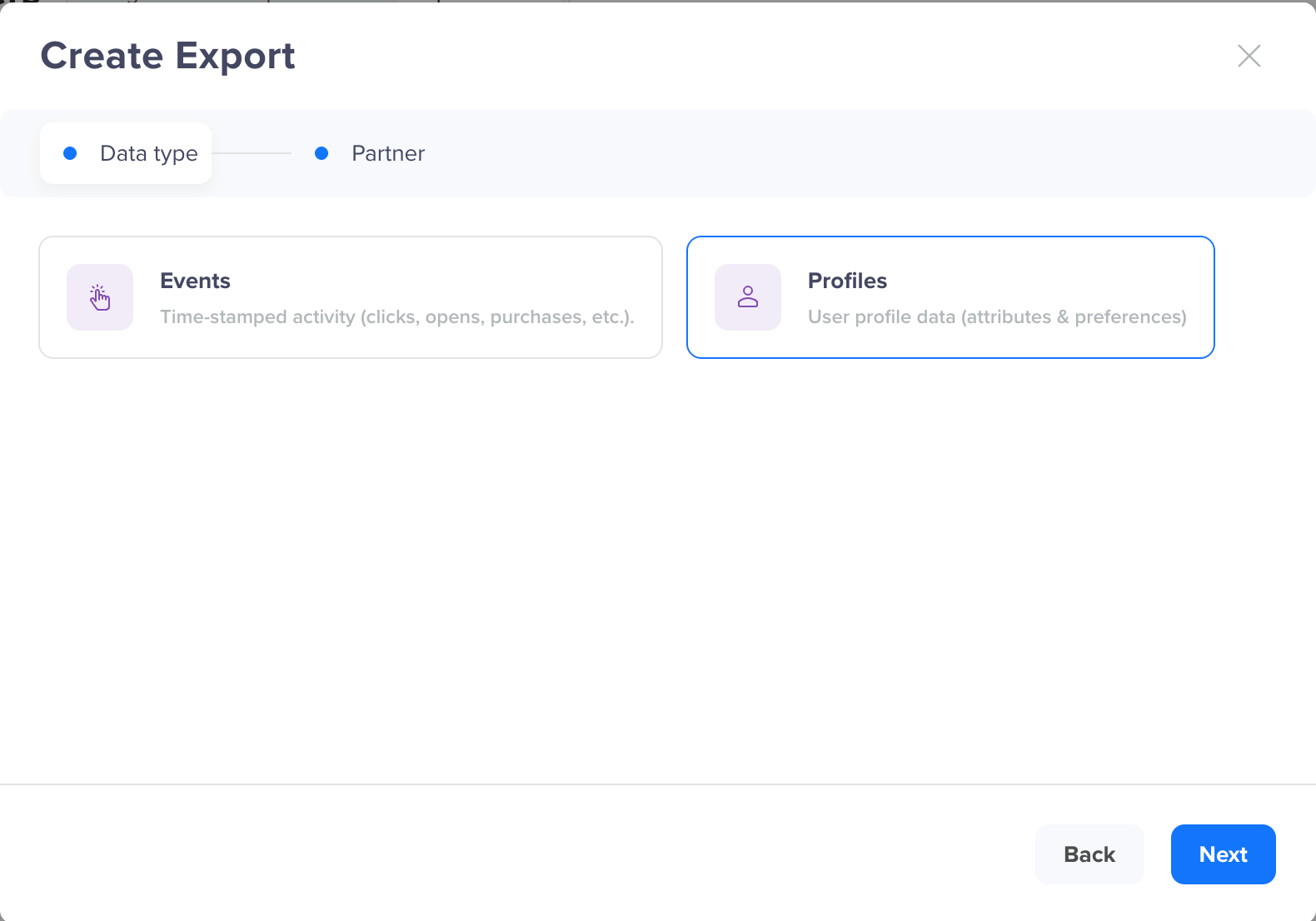
Data Type
-
Under Partner, select where you want to send the export and click Start. Selecting a partner affects the first field you’ll see in Storage & file details: it appears as Storage bucket for Amazon S3 and Google Cloud, and as Storage blob for Microsoft Azure.
- Amazon S3
- Google Cloud
- Microsoft Azure
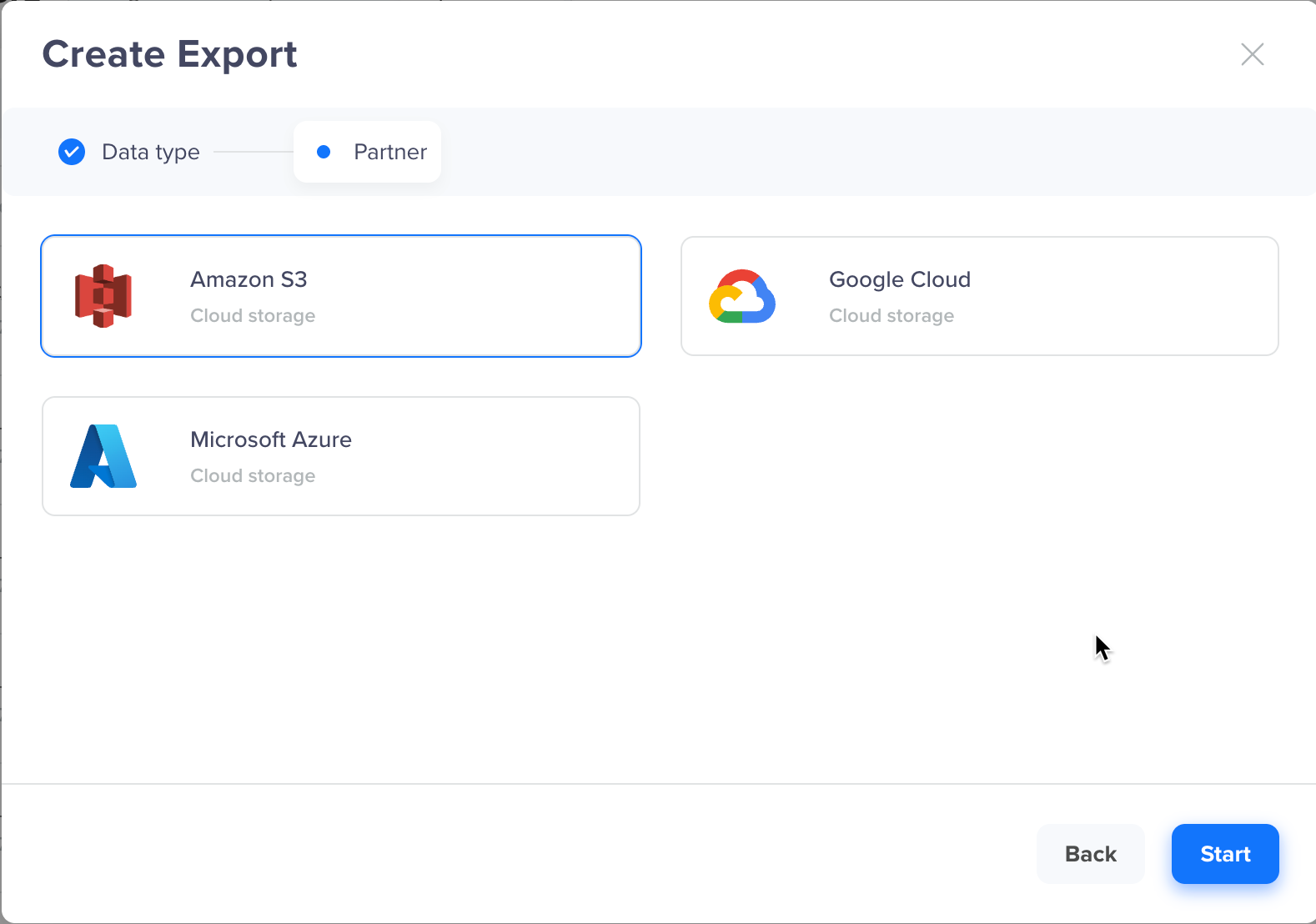
Select Partner
The partner export window displays. If you are exporting user profiles and using enhanced export flow, refer to Profile Exports.
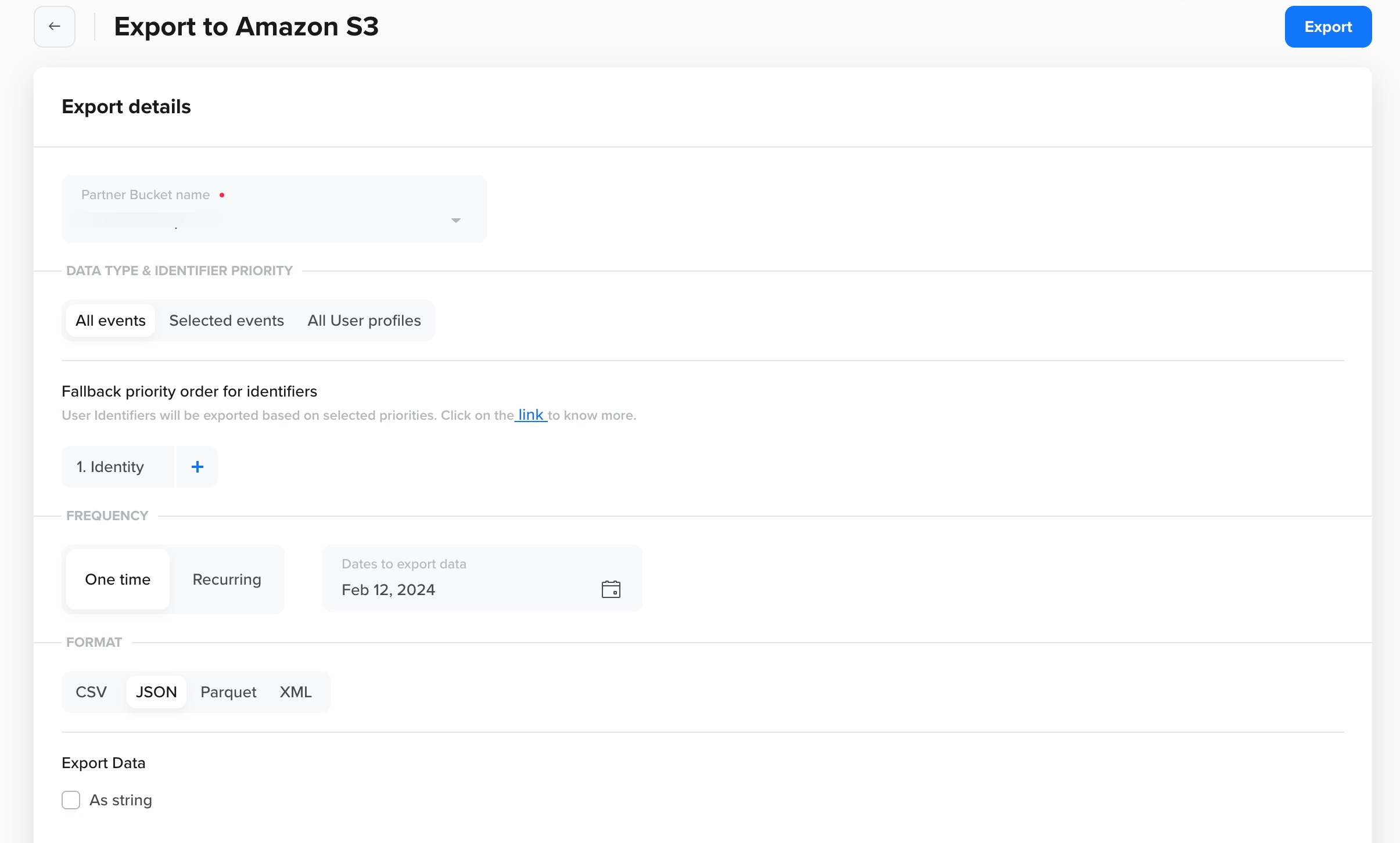
Enter Export Details
- Configure the following Export details:
- Partner Bucket name: Name of the partner bucket. Choose the required partner bucket from the drop-down list.
- DATA TYPE & IDENTIFIER PRIORITY: Select the data to export.
- Events: All events or Select events.
- Profiles: All user profiles.
- Fallback priority order for identifiers: Set priorities 1, 2, and 3 for Identity, Email, and Phone Number. (Applies to All events and All user profiles.)
- FREQUENCY:
- One time: A single export for the selected export type. You can export data up to the last 60 days. You can create an export for a specific day, date range, previous month, current month, and more.
- Recurring: Set up a recurring export that exports all the new events or user profiles captured in the last window. You can export data as frequently as every 4 hours and up to once every 24 hours.
- Dates to export data: The export starts at 12:00 a.m. on the specified date by default.
- FORMAT: JSON, XML, CSV, and Parquet.
- Export Data: If you choose As string, the data is sent as a string. If you do not select the box, data is sent in its original format.
Profiles one-time export
Before running a one-time profile export, stop any scheduled recurring profile export.
- Click Export. A confirmation message displays at the top of the Exports page. The status for each export is displayed as PENDING as soon as the export is created, changes to RUNNING after processing starts, and to DONE when the export is complete.
Stop Export
You can also stop the export that you have created. Click the
icon for the export request you want to stop, and then click Stop to confirm.
You can verify if the export is created on your cloud platform using Request ID as follows:
- Amazon S3
a. Log in to your AWS account and navigate to the S3 console.
b. Search your Bucket from the Buckets page and then click the bucket name.
c. Copy the Request ID from the activity log and search with that ID. You should see your respective file there.
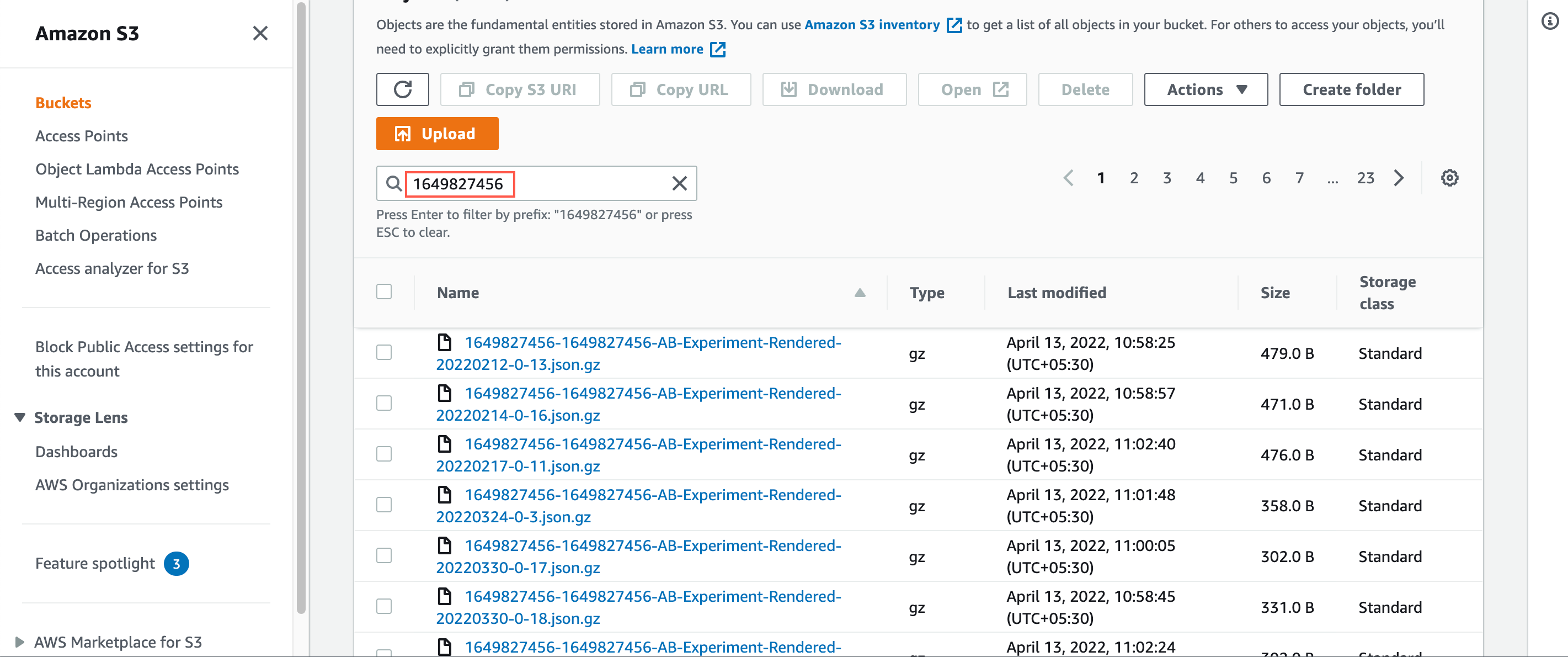
New Amazon S3 Export Displays on Amazon S3 Dashboard
- Google Cloud
Select Storage from the left panel of Google Cloud. Navigate to the Bucket details page and search with therequestid. All the exported files are displayed.
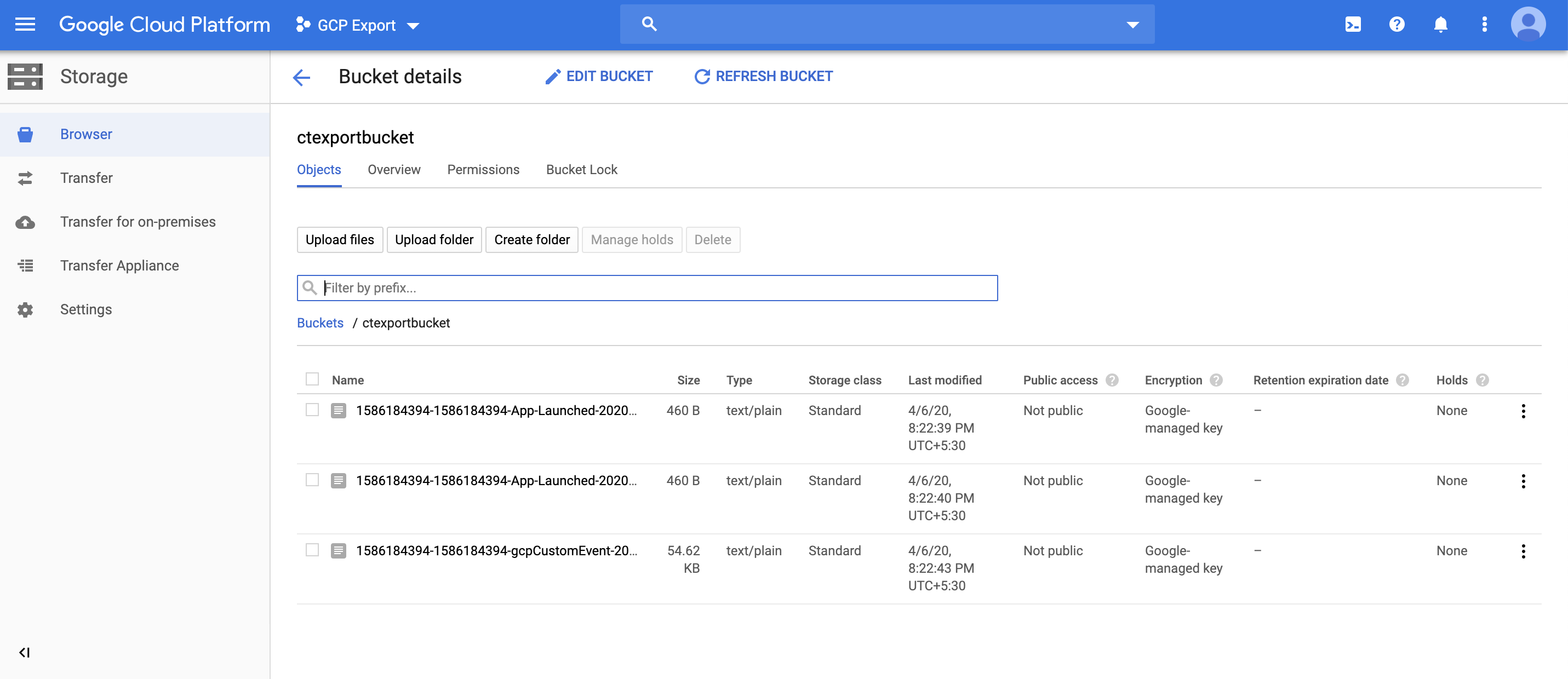
New Google Export Displays on Google Cloud
- Microsoft Azure
Log in to your Microsoft Azure account and select the Storage account under Resources. Click the Blob service link under the Properties tab and select the Container where you exported the data. (Optional) Click Switch to Access Key if you encounter any authorization error after selecting the Container.

New Export Displays on Microsoft Azure Dashboard
Export Format
This section provides information about the file format and naming conventions for the files exported to your storage destination.
File Name Format
-
File Name Format for Event Export
The example below shows the file name format for event export:<export request id>-<timestamp of the export run>-<event name>-<yyyymmdd>-<file index>-<database-id>.json- Export request ID, Timestamp of the export run, Event name, File index (files are chunked to ~100 MB), Database ID, and file format.
-
File Name Format for User Profile Export
The example below shows the file name format for user profile export:<account id>-<request id>-<timestamp of the export run>-<database-id>-<file format>.gz- Account ID (CleverTap project ID), Request ID, Timestamp of the export run, Database ID, and file format.
File Data Format
Files are split by event names for event exports, and each file will have all event data for the given period for the event.
JSON
The first line of the file contains the event name. After the first line, each line is JSON describing the timestamp, object id, and event properties.
{
"profile": {
"identity": "dqsndckfk234"
},
"ts": 20171109000015,
"eventProps": {
"ct_connected_to_wifi": "false",
"ct_bluetooth_version": "ble",
"ct_bluetooth_enabled": "false",
"ct_sdk_version": 30107,
"ct_latitude": -6.1975594,
"ct_longitude": 106.52913,
"ct_os_version": "5.1.1",
"ct_app_version": "2.30.1",
"ct_network_carrier": "3",
"ct_network_type": "4G"
}
}
CSV
CSV files are comma-delimited and have each event in separate rows.
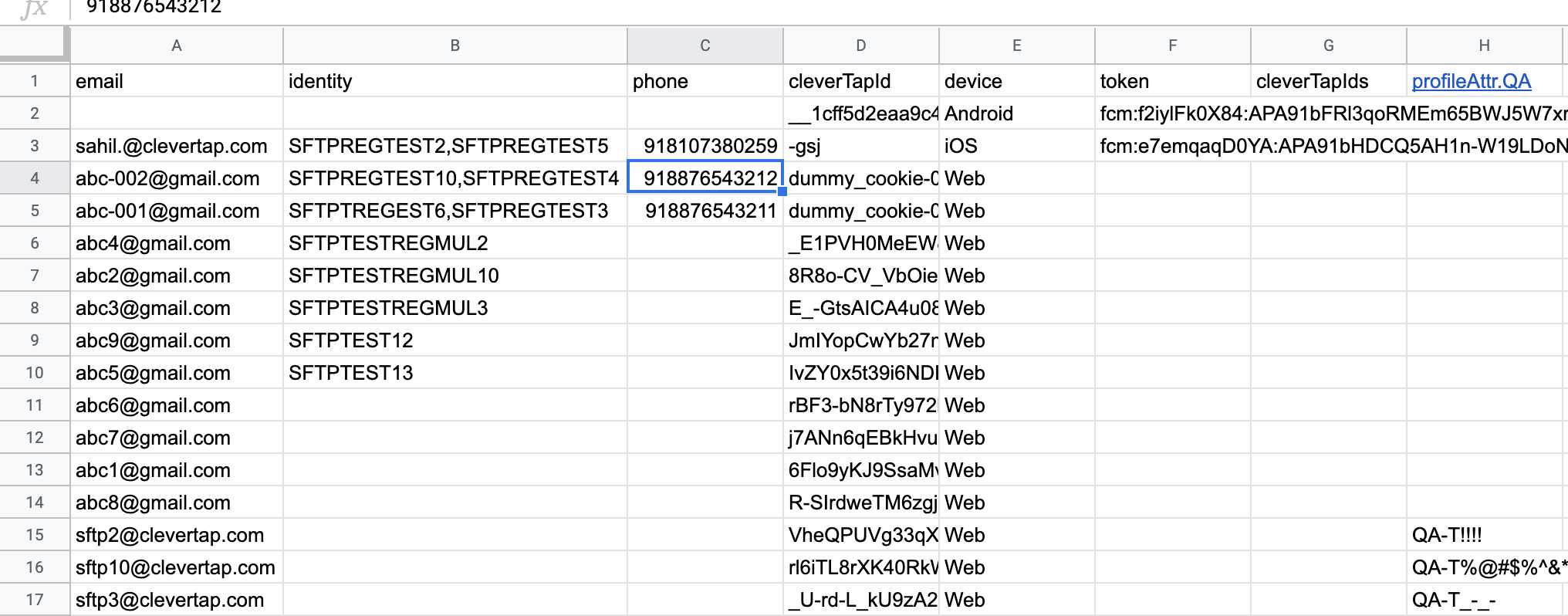
Sample CSV File
XML
XML has the timeStamp, eventName, followed by eventProperties.
<Event>
<ts>20200220130735</ts>
<eventName>Export Custom Event</eventName>
<profile>
<all_identities>[email protected]</all_identities>
<platform>Web</platform>
<email>[email protected]</email>
</profile>
<deviceInfo>
<browser>Others</browser>
</deviceInfo>
<eventProps>
<entry>
<key>CT Source</key>
<value>API</value>
</entry>
<entry>
<key>Category</key>
<value>Mens Watch</value>
</entry>
<entry>
<key>Product name</key>
<value>Casio Chronograph Watch</value>
</entry>
<entry>
<key>Price</key>
<value>59.99</value>
</entry>
<entry>
<key>Currency</key>
<value>USD</value>
</entry>
</eventProps>
</Event>
Parquet
Parquet has a timestamp, eventName, and eventProperties for each event.
Parquet File Format
Parquet is an open-source file format for Hadoop. Parquet stores nested data structures in a flat columnar format. Currently, exports in Parquet format are compressed as .parquet.gzip. Contact the Customer Support Team if you wish to get the file as .parquet, i.e., without any additional compression.
Prioritize User Identity for Exports
The export file includes an identity column with the user's Identity, Phone Number, or Email values. These values are set based on the identities configured in the CleverTap dashboard under the Settings > User Identity page. This feature lets you prioritize the identifier you want to export in the identity column.
Let us understand how the prioritization works based on the identities selected in the User Identity page:
- If you select only Identity, export includes the identity value. The export file's identity column is empty if it is unavailable.
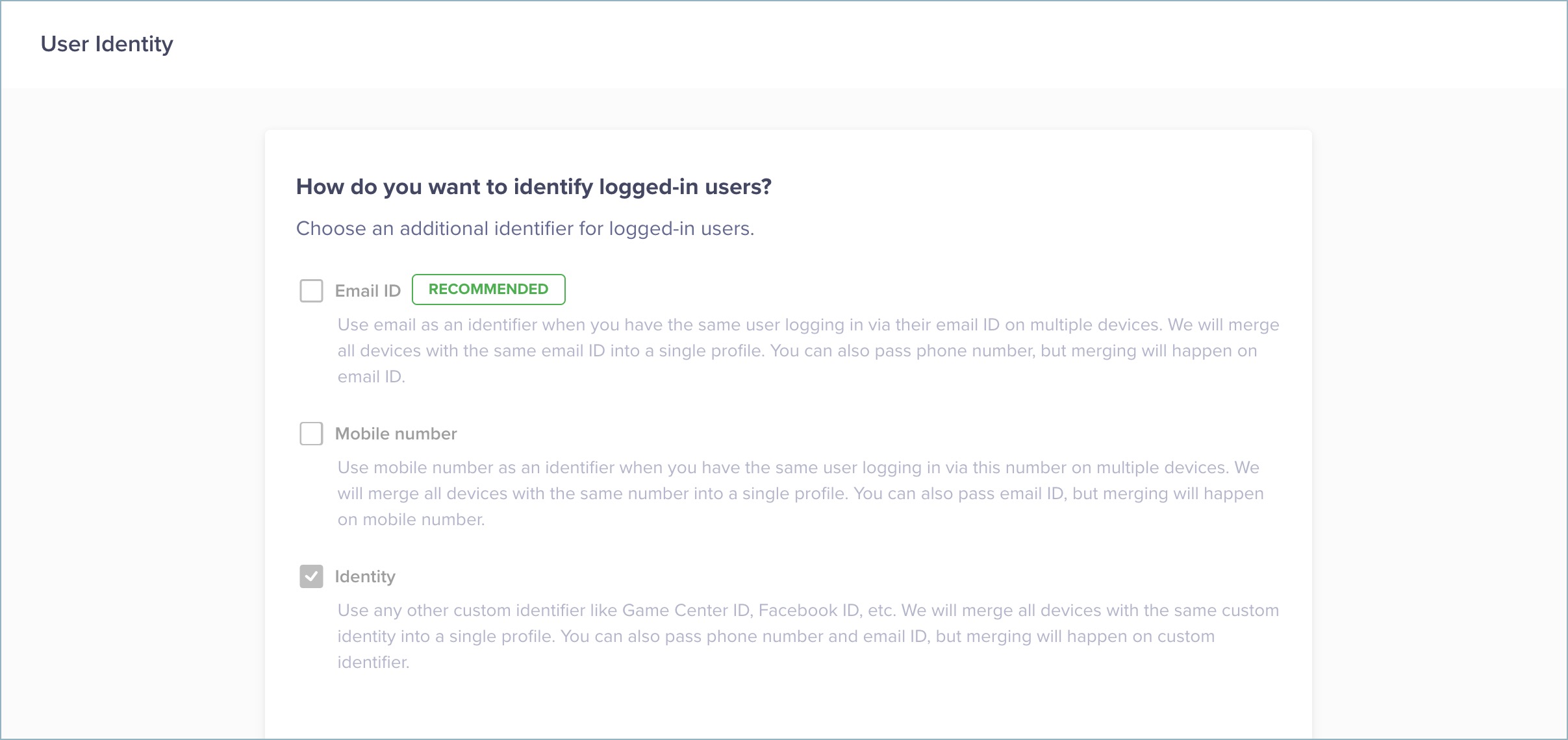
- If you select multiple identifiers, you must set the priorities on the Export page. For instance, you set Priority 1 to Identity and Priority 2 to Email ID. When exporting data, the export prioritizes the Identity value for the identity column. If it is absent, the Email ID is exported under the identity column of the export file. If both are missing, the column remains empty.
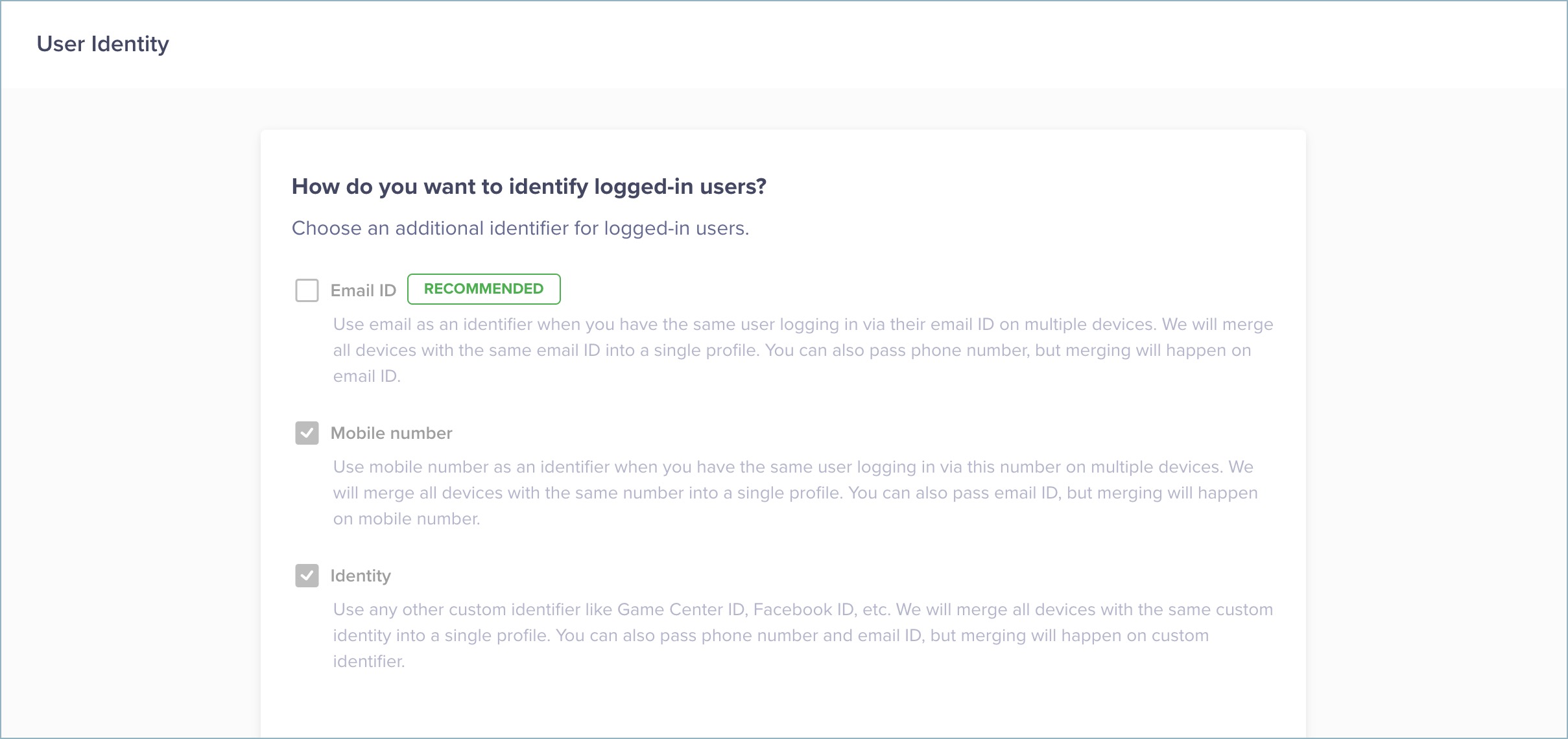
Key Points to Remember
- If you change the identity later, the export works according to the set priority. To prioritize the modified identities, edit your export.
- This feature applies only to the following export types: All events and All user profiles.
- For the old running export, this configuration or prirotization is not applicable. You can add the prioritization by editing the running exports.
To prioritize user identity for exports:
- Go to Partners > Exports.
- Hover over the required AWS S3 export. Click the Edit button.
- Under Fallback priority order for identifiers, set up the priority 1, 2, and 3 for the required identities from the drop-down list.

Edit Export Priority
FAQs
This section consolidates FAQs that apply to the legacy creation flow.
Do CleverTap data exports allow special characters?
Yes, CleverTap data exports allow the following special characters:
- Supports Unicode (UTF-8) character encoding.
- Replaces Whitespace, Tab, Slash, and null (\0) with a hyphen.
- Replaces control characters with
?. - Supports emoji characters; some emojis (UTF-16) may not render properly.
How does recurring export work?
On day one, the entire user profile data is sent. From day two onwards, only updates or additions are exported (for example, new profiles or updates to user properties/communication preferences). You can export data as frequently as every 4 hours and up to once every 24 hours.
Can I run a one-time Profiles export if a recurring Profiles export is active?
Before running a one-time profile export, stop any scheduled recurring profile export.
What formats are supported?
JSON, XML, CSV, and Parquet. Parquet is compressed as .parquet.gzip in the legacy flow.
How are large exports chunked?
We chunk the data across multiple files for larger exports. File sizes are limited to ~100 MB to make them more consumable. The file index indicates the file number in the series.
What other ways can I export data from CleverTap?
- Export via API (see API Overview).
- Find People: Download the profile data directly from the CleverTap dashboard through Segments → Find People → View Details → download under Total users.
- Data Exports to your storage destination (this legacy flow).
Updated 21 days ago
